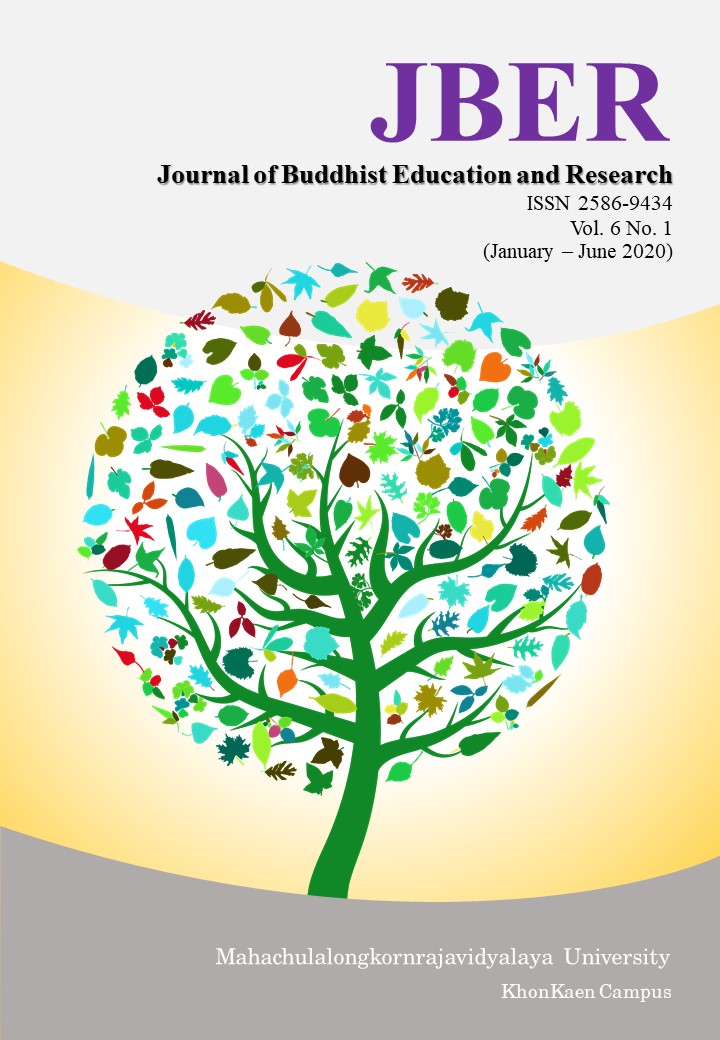การบริหารงานตามหลักพรหมวิหาร 4 ของผู้บริหารโรงเรียนศูนย์เครือข่ายพัฒนาคุณภาพการศึกษาหนองกุงศรี 2 สังกัดสำนักงานเขตพื้นที่การศึกษาประถมศึกษากาฬสินธุ์ เขต 2
คำสำคัญ:
หลักพรหมวิหาร 4, การบริหารบทคัดย่อ
บทความนี้ มีวัตถุประสงค์ 1) เพื่อศึกษาระดับการบริหารงานตามหลักพรหมวิ หาร 4 ของผู้บริหารโรงเรียนศูนย์เครือข่ายพัฒนาคุณภาพการศึกษาหนองกุงศรี 2 สังกัดสำ นักงานเขตพื้นที่การศึกษาประถมศึกษากาฬสินธุ์ เขต 2 2) เพื่อเปรียบเทียบการบริหารงานตามหลักพรหมวิหาร 4 ของผู้บริหารโรงเรียนศูนย์เครือข่ายพัฒนาคุณภาพการศึกษาหนองกุงศรี 2 สังกัดสำนักงานเขตพื้นที่การศึกษาประถมศึกษากาฬสินธุ์ เขต 2 จำแนกตาม เพศ อายุ และประสบการณ์การทำงาน 3) เพื่อศึกษาข้อเสนอแนะเกี่ยวกับการบริหารงานของสถาน ศึกษาตามหลักพรหมวิหาร 4 ของผู้บริหารโรงเรียนศูนย์เครือข่ายพัฒนาคุณภาพการศึกษาหนองกุงศรี 2 สังกัดสำนักงานเขตพื้นที่การศึกษาประถมศึกษากาฬสินธุ์ เขต 2 กลุ่มตัวอย่างที่ใช้ในการวิจัย ได้แก่ ครูโรงเรียนศูนย์เครือข่ายพัฒนาคุณภาพการศึกษาหนองกุงศรี 2 จำนวน 133 คน เครื่องมือที่ใช้ในการเก็บรวบรวมข้อมูล ได้แก่ แบบสอบถามมาตราส่วนประ มาณค่า 5 ระดับ มีความเที่ยงตรง (IOC) อยู่ระหว่าง 0.67 - 1.00 และมีค่าความเชื่อมั่นทั้งฉบับ เท่ากับ 0.984 วิเคราะห์ข้อมูลโดยใช้โปรแกรมคอมพิวเตอร์สำเร็จรูป สถิติที่ใช้ในการวิเคราะห์ข้อมูล ได้แก่ ความถี่ ร้อยละ ค่าเฉลี่ย และส่วนเบี่ยงเบนมาตรฐาน เปรียบเทียบความแตกต่างระหว่างตัวแปรโดยใช้ t-test และ F-test (One-way ANOVA)
ผลการวิจัยพบว่า
1) การบริหารงานตามหลักพรหมวิหาร 4 ของผู้บริหารโรงเรียนศูนย์เครือข่ายพัฒนาคุณภาพการศึกษาหนองกุงศรี 2 สังกัดสำนักงานเขตพื้นที่การศึกษาประถมศึกษากาฬสินธุ์ เขต 2 โดยรวมและรายด้านมีค่าเฉลี่ยอยู่ในระดับมากที่สุด เรียงลำดับจากมากที่สุดไปหาน้อยที่สุด คือ ด้านเมตตา ด้านกรุณา ด้านมุทิตา ด้านอุเบกขา ตามลำดับ
2) เปรียบเทียบการบริหารงานตามหลักพรหมวิหาร 4 ของผู้บริหารโรงเรียนศูนย์เครือข่ายพัฒนาคุณภาพหนองกุงศรี 2 สังกัดสำนักงานเขตพื้นที่การศึกษาประถมศึกษากาฬ สินธุ์เขต 2 ตามความคิดเห็นของครูจำแนกตามเพศ อายุ และประสบการณ์การทำงาน โดย รวมและรายด้าน ไม่แตกต่างกัน
3) ครูได้ให้ข้อเสนอแนะเกี่ยวกับการบริหารงานของสถานศึกษาตามหลักพรหมวิหาร 4 ของผู้บริหารโรงเรียนศูนย์เครือข่ายพัฒนาคุณภาพการศึกษาหนองกุงศรี 2 สังกัดสำนักงานเขตพื้นที่การศึกษาประถมศึกษากาฬสินธุ์ เขต 2 ทั้ง 4 ด้านดังนี้ ด้านเมตตา ผู้บริหารกล้าแสดงออก และกล้าตัดสินใจด้วยเหตุผลที่ประกอบด้วยเมตตาธรรม เข้าใจถึงปัญหาและความต้องการของบุคลากร ผู้บริหารมีวิสัยทัศน์ที่ดี ปรารถนาดีต่อเพื่อนร่วมงานเสมอ ด้านกรุณา ผู้บริหารมีเวลาในการให้คำปรึกษากับผู้ใต้บังคับบัญชา และควรมีการสอบถามปัญหาเรื่องต่างๆ ด้านมุทิตา ผู้บริหารแสดงความยินดี ความชื่นชม เพื่อเป็นขวัญและกำลังใจในการปฏิบัติงานของผู้ใต้บังคับบัญชา ด้านอุเบกขา ผู้บริหารมีความเป็นกลางแก่บุคลากรทุกคนด้วยความเสมอภาค ตัดสินด้วยความเป็นธรรม ไม่เอนเอียงฝ่ายใดฝ่ายหนึ่ง
เอกสารอ้างอิง
ณัชชา อมราภรณ์. (2557). การบริหารงานตามหลักพรหมวิหารธรรมของผู้บริหารสถานศึกษาเขตสายใหม. วิทยานิพนธ์ปริญญาพุทธศาสตรมหาบัณฑิต สาขาวิชารัฐประศาสนศาสตร์. บัณฑิตวิทยาลัย มหาวิทยาลัยมหาจุฬาลงกรณราชวิทยาลัย.
ธานินทร์ ศิลป์จารุ. (2555). การวิจัยและวิเคราะห์ข้อมูลทางสถิติด้วย SPSS และ AMOS. (พิมพ์ครั้งที่ 13). กรุงเทพฯ: บิสซิเนสอาร์แอนด์ดี.
นงเยาว์ ภูน้ำย้อย. (2558). การใช้หลักพรหมวิหาร 4 ในการบริหารศูนย์พัฒนาเด็กเล็ก สังกัดองค์การบริหารส่วนตำบล อำเภอยางตลาด จังหวัดกาฬสินธุ์. สารนิพนธ์ศึกษาศาสตร์มหาบัณฑิต. สาขาวิชาการบริหารการศึกษา. บัณฑิตวิทยาลัย มหาวิทยาลัยมหามกุฏราชวิทยาลัย.
ประเวศ วะสี. (2544). ยุทธศาสตร์ทางปัญญาและการปฏิรูปการศึกษา. ในรายงานการประชุม เรื่อง วิสัยทัศน์และยุทธศาสตร์ทางการปฏิรูปทางการศึกษา : วาระแห่งชาติ. กรุงเทพฯ: วัฒนาพานิช.
พรนภา ชำนินอก. (2558). การใช้หลักพรหมวิหาร 4 ในการบริหารโรงเรียนศูนย์เครือข่ายพัฒนาคุณภาพการบริหารการศึกษายางตลาด 3 จังหวัดกาฬสินธุ์. สารนิพนธ์บัณฑิตวิทยาลัย มหาวิทยาลัยมหามกุฏราชวิทยาลัย.
พระพรหมคุณาภรณ์ (ป.อ. ปยุตฺโต). (2551). พจนานุกรมพุทธศาสตร์ ฉบับประมวลธรรม.(พิมพ์ครั้งที่ 16). กรุงเทพฯ: บริษัท เอส.อาร์ พริ้นติ้ง แมส โปรดักส์ จำกัด.
พระมนัส อคฺคธมฺโม (ก้อนใหญ่). (2554). ภาวะผู้นำของผู้บริหารสถานศึกษาตามหลักพรหมวิหาร 4. วิทยานิพนธ์พุทธศาสตรมหาบัณฑิต. สาขาวิชาการบริหารการศึกษา. บัณฑิตวิทยาลัย มหาวิทยาลัยมหาจุฬาลงกรณราชวิทยาลัย.
พิณสุดา สิริธรังสี. (2552). ภาพการศึกษาไทยในอนาคต 10-20 ปี. รายงานการวิจัย.กรุงเทพฯ: สำนักนโยบายและแผนการศึกษา สำนักงานเลขาธิการสภาการศึกษา.





